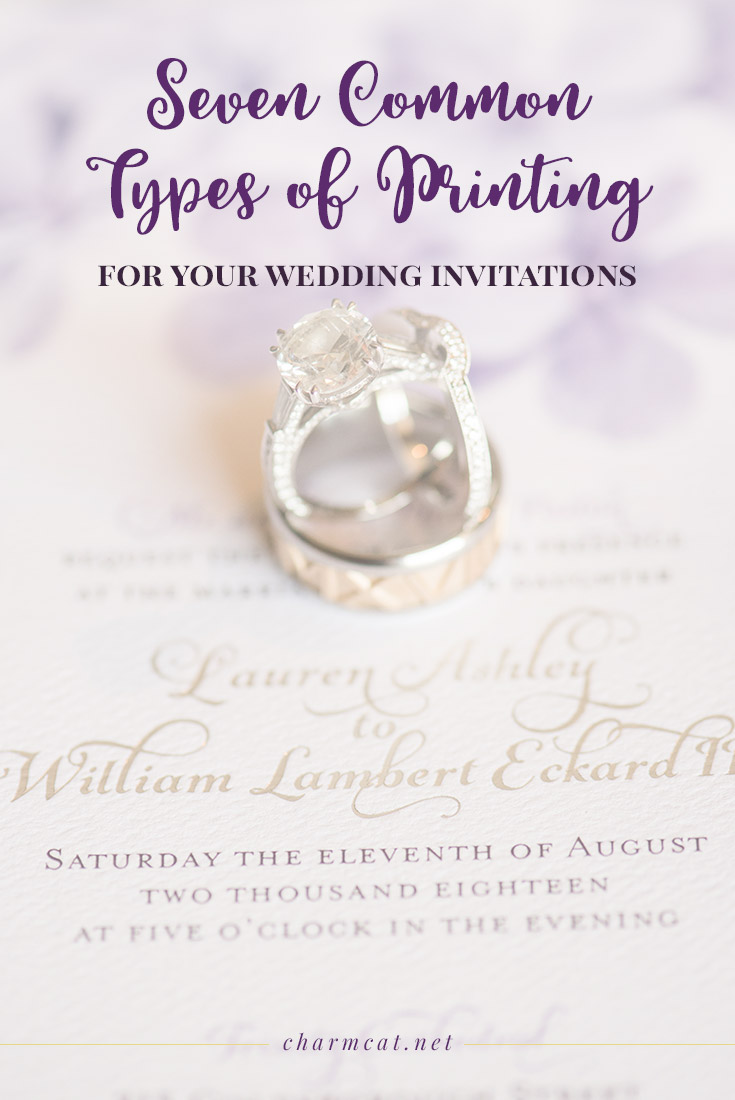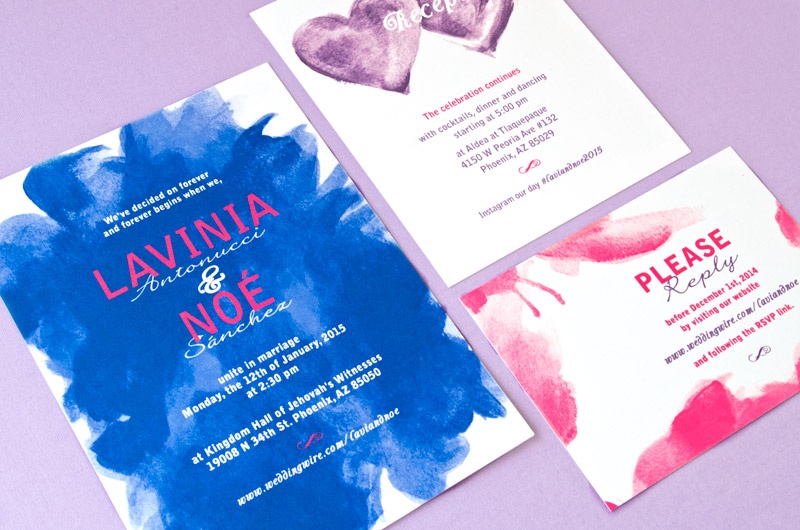Types of Wedding Invitation Printing
Category: All About Wedding Invitations | Published on: Apr 24, 2019
Editor’s Note: This post was originally published on September 4, 2015, but it’s been updated with awesome new tips and helpful links!
When you’re designing your wedding invitations, it’s important to remember that the type of ink and printing style you use can be an effective part of the artistry of your invites. Here are some of the most common types of printing you’ll run into when browsing your stationery options.

1. Digital (also known as Flat)
Digital printing is currently the most common, most cost-effective, and simplest printing method available. It’s pretty similar to the laser printer you have at work, except that most industrial digital printers would take up your entire desk! Digital printers have come a long way and can produce a pretty wide range of rich colors.
A digital printer is fast, smooth, and economical, which is why digital printing is the most common way to produce invitations. Cards can cost as little as $1.00 per piece when ordering in bulk. Plus you can upgrade with a wide variety of special papers that come digital-ink friendly.
1B. Digital White
Digital printing has made great strides in the last few years. Now specialty digital printers can offer white ink and full color ink on colored paper. Digital white usually costs a few cents more than regular digital printing, but created a beautiful effect! By printing white ink and then printing color on top, you can also get a rich print job at a relatively economical price.
1C. Digital Foil
In the last year, a new digital print method has gained popularity: digital foil! This is a type of printing that uses heat to adhere foil to paper. It’s become popular as a cheaper alternative to true stamped foil. Unlike stamped foil (below), digital foil is completely flat, and the detail isn’t as crisp.
2. Letterpress
Letterpress printing calls back to the first printing presses: it uses metal plates to press the ink onto the paper. The process leaves an impression behind, giving anything printed with letterpress an awesome texture. Plus, letterpress printing requires thick, pliable paper which adds a tactile element to the invite. Cotton paper is the most primary choice among letterpress printers. It’s is softer that wood pulp papers (“typical” paper) and as a result feels almost …friendlier.

Each metal plate is designed for only one ink at a time, which means, the cards essentially have to be printed once for each color. Of course, because each card requires a new custom metal plate, and because each card has to be fed into the letterpress machine, cards printed this way can run around $1.50-2 extra per color. Many couples and designers find the cost to be worth it for the character it adds, but usually limit the colors to one or two.
Using a technique called overprinting, you can make your colors go farther. For example, you can pay for blue and pink, but also include purple in the areas where the ink overlaps.
You can also combine flat printing and letterpress to create something with more color variety that still fits into your budget.
3. Foil Stamping
Foil is a great way to add some pizazz to any invitation! Foil adds class and brightens up the design. It catches the light in a way ink doesn’t. Colors are becoming more widely available, and now you can order foil in just about any color of the rainbow.

Foil is usually applied the same way as letterpress, using a metal plate to press the foil into the paper with an adhesive agent. The up-charge is a little more than letterpress, running around $2-3 extra per piece.
Bonus: Combine printing types to save on cost. If you really want foil or letterpress, get one color done and do the rest in digital printing. This way you can have your foil and eat it, too.
4. Spot Color (Offset printing)
Spot color prints flat like digital printing, but the similarities end there. Digital printing has four primary colors: magenta, cyan, yellow, and black. This gives digital printing a pretty good color range, but there are some colors it just can’t reproduce. Colors that are extremely vibrant, neon, or ultra-rich are way out of its gamut. This is where spot color printing shines.

Because spot color starts with 12 primary colors, it can create pretty much any color you can imagine. Don’t go color crazy, though. Like letterpress, each color requires a new plate, and another run through the printer. Unless you’re ordering quantities in the thousands, expect to add about $1.50 to your cost per piece.
5. Engraving
Before the days of digital presses, wedding invitations were printed using engraving. With this type of printing, your printer creates a metal plate which is then inked and pressed onto the paper. The ink is heavy and is slightly raised. You’ll typically see tissue with this type of invitation to keep the ink from smearing.
If you want to go this classic route, you’ll need to find a specialized printer that only does engraving. The setup is pretty pricey. There’s a steep discount for higher quantities, but you could be looking at as much as $20.00 an invitation if you’re keeping your numbers small.
6. Thermography
Thermography is a modern mix between engraving and spot color. Thermography uses heat to essentially “melt” ink and glue onto the paper, similar to craft embossing. The finished product is shiny, like plastic. The colors are usually limited to the 12 primary spot colors, but if you want the raised texture with color, thermography is your best bet.
Thermography isn’t as expensive as engraving, but again, you’ll be paying for each color you want printed. Expect an extra $2 per piece per color.
7. Laser Cut
If you really want to make an impression, you can get your invitations laser cut. This technique uses no ink, but instead cuts away paper to create the design and the words. Intricate laser cutting looks like lace and makes a big first impression!
For laser cutting, the price depends on how long each piece takes to cut. So the more intricate the design, the more it’ll cost. It could be anywhere from one dollar extra to ten dollars extra.
What’s the turnaround time?
Digital printing is by far the fastest! You can usually get an immediate quote and have your order printed on-demand in a day or two. If you’re on a tight timeline, digital is the way to go.
For the other methods, printing can take weeks, so if you want a premium printing method be sure to plan ahead! For some, like laser cutting, you’ll have to have the design done before you can even price it out.
Fortunately, the wait is usually more than worth the end result!
Got all that?
Pin this graphic for later reference!

— Ashleigh
See more posts about: digital printing, emboss, engraving, flat printing, foil, foil stamping, letterpress, printing, printing types, printing wedding invitations, priorities, spot color, thermography
Responses
-
Thanks for sharing this information.
-
Great Post, Well Explained with attractive Images
-
Very helpful
-
Very useful information ! Thanks for sharing
-
Glad I could help!
-
-
Letterpress for sure!
Comment Policy
Be nice. If you’re not, we’ll remove your comment and ban you from the conversation.
Please check out our Welcome Policy.


Leave a Comment